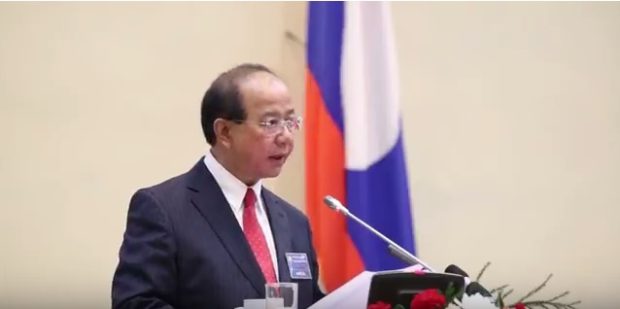
Prof. Dr Bosengkham Vongdara. SCREENGRAB FROM YOUTUBE
Minister of Information, Culture and Tourism Prof. Dr Bosengkham Vongdara told the National Assembly (NA) yesterday that to achieve this goal the government reaffirmed its commitment to develop basic infrastructure, especially in the field of transportation, to better link with the region.
In the transportation sector, Prof. Dr Bosengkham stated that the government allocated a substantial budget to improve such works, including for airports, road access and other related facilities to attract more visitors across the nation.
Laos possessed a variety of “simply beautiful natural, cultural and historical tourism sites with unique characteristics linked to the vibrant diversity of the nation’s multi-ethnic groups, he said.
The government hopes to see the country attract at least 5 million foreign visitors next year, an increase from the 4.8 million tourists expected in 2017, he said.
International tourists numbering 6.2 million are expected annually by 2020.
During the meeting, Prof. Dr Bosengkham also spoke briefly about the tourism framework development over the past year and the current situation of the sector.
He said the country has had considerable success in developing its tourism industry, which is now second only to mining in its economic contribution.
In 2011, the country welcomed over 2.7 million international visitors, rising to 4.2 million in 2016 generating revenue of US$724 to the Lao economy.
“This impressive growth has significantly supported to the social-economic development of Laos,” Prof. Dr Bosengkham said.
The sector retains considerable room for further growth, although visitor arrivals are not well diversified and more needs to be done to attract tourists to stay in the country for longer as a primary strategy for increasing the value of the tourism industry.
A large proportion of visitor arrivals are day-trippers from Thailand who return on the same day.
Growth in tourism has been made possible by gradual improvements in infrastructure.
Hotels and guest houses have proliferated from the handful that existed in the mid-1990s.
Transport connections have also improved through investment in roads, bridges and airports.
At present, Laos has four international airports, 27 international checkpoints, 432 travel agencies with around 1,275 tourist guides, and about 3,000 accommodation providers including hotels, resorts and guesthouses to welcome visitors.
According to a recent report from the ministry, there were 545 registered hotels in 2016, up from 542 in 2015.
Also, Laos has signed visa exemption agreements with 45 countries around the world to bring more foreign visitors to the country.
It seems likely that Laos could expect to see double-digit growth in both tourist numbers and visitor spending in years ahead as transport links improve, with tourism set to remain a key revenue stream for the nation, Prof. Dr Bosengkham added.
However, the vast majority of arrivals are likely to continue to be from within the region, linking the development of the industry closely to political and economic trends in neighboring countries.